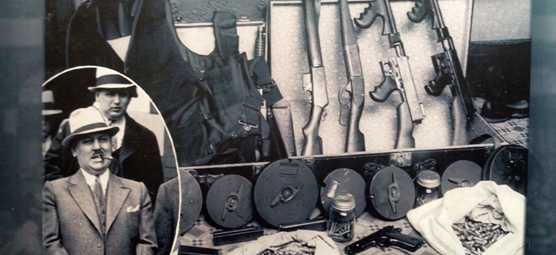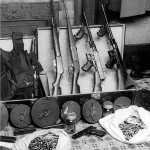The Actual Tommy Guns Used in the St. Valentine’s Day Massacre

Marcy Kennedy Knight is an award-winning writer who has written for television, theater, publications and the web.
Hours after the Massacre in the Clark Street garage, Major Fred Silloway’s statement that he would “have the killers that night’ hit local and national newspapers. But as hours turned into days, and days into weeks and weeks into months, witnesses either changed their stories, disappeared, were murdered or evidence simply “vanished.” It soon became evident that solving the “Crime of the Century” wasn’t going to happen anytime soon, if at all.
That all changed 10 months later on the night of December 14, 1929, in the town of St. Joseph, Michigan. After witnessing a minor traffic accident, Officer Charles Skelly stopped the driver who caused the fender-bender. The driver shot Officer Skelly three times then drove off; Skelly died three hours later. Before he died, Skelly identified the shooter as Fred “Killer” Burke. Burke’s home was raided and police found two Thompson Machine Guns with nine ammunition drums, two high-powered rifles, one sawed-off shot gun, ammunition estimated at 5,000 shells, six tear gas bombs and stolen bonds from a Jefferson Wisconsin Bank.
The Thompson Machine Guns were scientifically tested; they were not only the guns used to kill mobster Frankie Yale in New York the year before, but these were the exact guns used in the St. Valentine’s Day Massacre.
But why did Burke flee to St. Joseph after the St. Valentine’s Day Massacre? “Because it was ‘Capone’s Playground.” explained historian, author and Public Safety Officer Chriss Lyons. In her upcoming book, Capone’s Playground, Lyons writes about 25-year-old Officer Skelly, the capture of Burke (who was actually relieved the police had caught him) and the chain of events after the arrest. Several cities wanted to extradite Burke for his crimes, including Chicago for the St. Valentine’s Day Massacre, but they all realized that St. Joseph had the strongest case against Burke. Burke was tried and convicted for Skelly’s murder where he subsequently died at Marquette State Prison in Michigan. Burke never confessed to the St. Valentine’s Day Massacre, but he also never confessed to any of his other crimes.
The area was called “Capone’s Playground,” Lyons said, because gangsters came to western Michigan to enjoy themselves. “You think of Chicago and the brutality and the murders because brutality went along with the gangster. But when they were here, it was strictly play. That’s why this was called the playground. They literally came here to play golf, to partake in the Italian Fair, to shop, to go to the amusement park and to the beaches.”
Lyons, who has been in law enforcement for close to 20 years, added, “The gangsters weren’t there to start trouble. The police didn’t bother them, and they didn’t bother the police. Capone was known as a very generous tipper. There would be 12-year-old caddies on the golf course, and Capone would throw them a $100 tip. These boys probably didn’t have the concept of what $100 was, but their family did. The money was so desperately needed at that time as this was the Depression. People just saw him as a wealthy businessman. They knew who he was. I struggled with that for a while. How could people around here allow this to happen? It was their personal judgment that as long as Capone didn’t kill anyone, people were more accepting.”
Today, the two Thompson Machine Guns “are housed in the Berrien County Sheriff’s Department armory under lock and key,” explained Lyons. The two guns are taken out on a regular basis and fired. They have won many awards in the historical gun category with the NRA.
“There’s still a lot of misunderstanding about the guns. Lt. Mike Kline takes the guns out and tours with them. He would tell stories that when he went to NRA shows, people would be fascinated with the guns and they would say, ‘So these are kind of like the guns that were used in the Massacre?’ Mike would say, ‘No, these ARE the guns that were used in the Massacre.’ People would persist, ‘No really, is that what the guns looked like?’”
Lyons ended by saying, “Most people are only interested in the gangster part of it, Al Capone. There’s always the allure of the St. Valentine’s Day Massacre. “
Weapons Burke House – Image courtesy of Berrien County Sheriff’s Department
Feedback or questions? Email blog@themobmuseum.org







